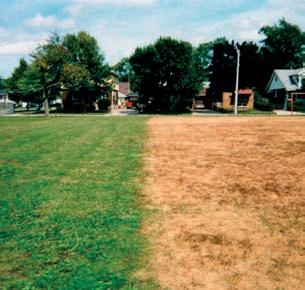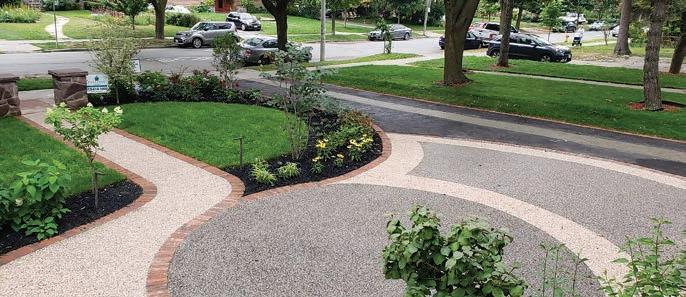Bracing for the (1)00 year storm Permeable paving technology rises to meet the storm water challenge BY MARK DOUGLAS WESSEL
ONE SURFACE CAN ABSORB a year’s worth of rainfall within an hour. Another serves as a repository for indigenous plants that can stand up to pedestrian and vehicular traffic. Yet another won the prestigious Red Dot Award, combining artistic flair with a surface that’s 30 per cent porous. The timing for these innovations couldn’t be better considering cities across Canada are struggling with higher incidence of flooding, loss of biodiversity and the heat sink phenomena. These are challenges landscape professionals are uniquely positioned to address. THE (1)00 YEAR STORM?
The municipal mindset with respect to water management used to be that hard surfaces were a good thing, because they helped to expedite the movement of rainfall into the storm drain system. Now, with climate change, what were once considered “100 year storms” are happening every few years. These severe weather events cause major problems in cities, including: sewage overflow into nearby lakes and streams, water pollution in the form of oils and chemicals originating from residential driveways, and downstream erosion caused by the sheer volume of runoff.
ALL POLITICS IS LOCAL
Responding to these challenges, Vancouver, B.C., has developed a comprehensive “Rain City Strategy” that includes an arsenal of solutions designed to keep water onsite in both public and private settings, including bioretention rain gardens, green roofs and
PurePave used in the entraceway of a home in Toronto’s High Park neighbourhood
12 | MAY 2021 | LANDSCAPE TRADES
permeable pavement. A few years back, the City of Kitchener, Ont., conducted an in-depth permeable pavement study and it is now in the midst of launching a program designed to ramp-up residential interest in keeping water on the home front. Plans are underway for financial incentives for residents to switch from hard to permeable paving surfaces and additional measures, such as rain barrel usage, are part of the mix as well. Ottawa, Ont., is even further along the process with its “Rain Ready Ottawa” program, that includes a subsidy of up to $5,000 per household to help cover the cost of various residential rainwater retention measures — including — you guessed it, permeable paving. “The city has already received dozens of requests from residents ahead of the launch… with many expressing interest in permeable paving,” says program coordinator Simon Greenland-Smith, adding this demand came “before any outreach or promotional efforts have been made.” Fortunately, permeable paving technology is keeping pace with the increased demand.
ABSORBING 4,000 LITRES IN ONE HOUR
PurePave, for example, can absorb a year’s worth of rainfall within an hour — a feat made possible by combining natural granite aggregate with a proprietary polymer binding agent. PurePave Technologies, based in Ottawa, Ont., says the surface of PurePave is 23 per cent porous and can absorb over 4,000 litres of water per square foot per hour.









